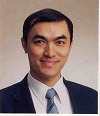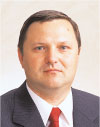|
|
 |
|
|
Software Engineering Laboratory |

Minetada Osano
Professor |

Ying-Hong Hang
Visiting Researcher |

Alexander Vazhenin
Assistant Professor |
|
The Software Engineering Laboratory aims to integrate new algebraic and formal techniques with emerging software engineering design methodology in order to solve practical problems of software development and maintenance while making effective use of software tools and engineering practice. The development of software systems is now regarded as among the most complex tasks performed by human kind. The problems due to the scale of this complexity affect the costs and time expendedon the construction of software systems. After being built, software systems may be unreliable, diAEcult to use and, even most seriously, their maintenance and evolution are generally fraught with unforeseen costs and peril. These problems, together withever-increasing demandfor software systems, comprise the software crisis. Our work spans the frame from requirements capture, design and specification to software maintenance, re-use and evolution. Lab members lead the Framework for Advanced Software Techniques Research Group, a cooperative project with other Laboratory and other University. Part of the research aims to develop maintenance process models in order to create a software maintenance environment to recover higher level documentation of existing software systems to bring them into intelligent Agent Systems . With this mechanism, existing software systems will bene??t from forward engineering tools provided by the UML environment. Sophisticated mathematical methods in our Agent System approach to software systems provide a foundation for the object-oriented paradigm and are now being applied in a variety of settings. The laboratory is constructing and providing the server of exercising and lecture for software engineering course for our university's students and also making a project of the software maintenance research and education. Student research as software lab focused on maintenance' and human resource management on UML and uni??ed process, risk management Department of Computer Software on UML and maintenance management with intelligent Agent system on Unified Process. Our SE lab obtained additionally so many powerful Linux workstations, so many personal computers, various printers and CASE tools.
Prof. Osano provides many research fields. One of those is as Software Robot that is constructed with the mechanism of humanbeing will be researched as artificial intelligence, artificial life, remembering model, speaking model s like human with using dates on computer, awake or awareness model, feeling of human,Transaction Analysis(TA)oncomputer, voice analysis of humanspeakingonTAandthe traAEc model(ITS) andPSAsupport system of a daily meal for the sick of diabetes on multi-agent system, Other is a research of arti??cial life which species theory of evolution system on the nature life are analyzed with simulation on Computer with developing new dynamical evolutionary algorithm and applied TSP(traveling salesman problem), immunity model and digital plant.
Prof. A. Vazhenin provides investigations related to research and development a multimedia programming technology, WEB-based programming tools as well as high-precision computations. Amultimedia technology is used for the interactive specification of application algorithms. This research isimplemented together with the Distributed Processing Laboratory. The key point of such technology is the use of self-explanatory components in a film format. A film is a series of color stills supported, if necessary, by text and voice/sound. Each still is to represent a view (some features) of objects or processes. In our approach, each method is considered as a plan of actions for solving a problem. To test our approach, we consider various computational methods and prepare knowledge of these methods in the film format. Matrix computations are under our special attention. They are the heart of most applications in scienti??c computing. The great attention is paid to the special visual language that is oriented to inputandverify arithmetic/logical expressions, as well as special user-oriented interface using multimedia icons and high-level program keyboards.
The other investigations are directed to research and development of basic elements of the WWW-oriented Workplace of Applied Programmer (W4AP). From the user's viewpoint, this workplace represents an application-oriented virtual machine being accessible via standard WEB-browsers. This means that the hardware/software features of theW4APserver shouldbehiddenfromthe applied user. The process of the research implementation is based on using modern technologies like object-oriented programming, clustering computational and multimedia resources, networking as well as parallel, distributed and client/server platforms and Internet Computing. The created system should also have the high-level of security because of the high risk of Internet-applications. The proposed approach allows to increase application programmer productivity, support parallel program transparency, and provide accessibility of parallel computers to large user populations. To imvolve this approach in the teaching process, investigations are also implemented in the framework of the SCCP-project.
|
| [vazhenin-001:2001] | A. Vazhenin and N. Mirenkov. Visual Programming System VIM. Programming and Computer Software, 27(4):217{231, 2001.
In this paper, aspects of creation of the visual programmingsystemVIM based on filmification of application algorithms andmethods are considered. Abstract self-explanatory films, which are series of frames/pictures with video, animation, audio, and other multimedia effects, are used for presentation of the method. Each frame of such a film corresponds to a certain stage, called computational step, of problem solution. A hierarchical organization of objects of such a system is suggested. The objects include both multimedia components, which demonstrate properties or an idea of the algorithm, and corresponding template programs serving for automated generation of the program created on the basis of the film specification and formulas defined by the user during the input dialog. |
| [vazhenin-002:2001] | A.Vazhenin, N.Mirenkov, andD.Vazhenin. Multimedia Representation of Matrix Computationsand Data. International Journal on Information Sciences, 27(4):97-122, 2001.
Distance learning, virtual universities, as well as knowledge discovery from the Internet are emerging to e??ect the worldwide transformation of educational systems and the establishment of knowledge-based societies. In this paper, we present an idea of smart "pieces of data/knowledge to be used for new types of the educational environment. As an example, we consider our approach for the multimedia representation of matrix computations. The approach is based on filmification" of methods and data, and related to special-purpose pictures and animations rendering results of computation and schemes of corresponding computational methods. To create these pictures and animations, as well as to manipulate films, special techniques and subsystems are considered. Film stills of three well-known methods are also provided. |
| [vazhenin-003:2001] | A. Vazhenin, N. Mirenkov, and Vazhenin D. Representation of Large NumericalInformation Arrays viaMultimediaObjects. Journal of Internet Technology, 2(4):263-273, 2001.
Easy-to-access data/knowledge techniques supported by the Internet allow us to try a great variety of new applications. However, this trend should be balanced by easy-to-understand data/knowledge techniques. In this paper such techniques for a multimedia representation of matrix computations based on filmification of application methodsanddata are considered.The multimedia representation is related to special-purpose pictures and animations rendering intermediate/final results of computation and schemes of corresponding computational methods. To support rendering data, a multimedia interface and matrix filtration and matrix scaling techniques are used. To support rendering computational schemes, a film technology is used. Within the framework of this technology, self-explained series of stills presenting computational schemes, an interface supporting formula attachment to still structures, a program generation subsystem as well as WEB-based environment are discussed. |
| Referred Proceeding Papers |
| [vazhenin-004:2001] | A. Vazhenin and D. Vazhenin. Applied Programming on WEB-based Environment. In Editors V.V. Kluev, N.E. Mastorakis, editor, Topics in Applied and Theoretical Mathematics and Computer Science, Proceedings of the 2nd WSEAS Multiconference on Applied and Theoretical Mathematics, pages 287{292. WSEAS, WSEAS Press, Dec. 2001.
he paper describes basic elements of the WWW-oriented Workplace of Applied Programmer (W4AP). From the user's viewpoint, this workplace represents an application-oriented virtual machine being accessible via standard WEB-browsers. This means that the hardware/software features of the W4AP server should be hidden from the applied user. The proposed software has the unified style for different programming platforms, special tools optimizing and controlling the program creation and implementation as well as an environment combining visual and traditional programming technologies. |
| [vazhenin-005:2001] | A. Vazhenin and D. Vazhenin. W4AP:WWW-workplace for Applied Programming. In Proceedings of the Fourth International Conference on Human and Computer, pages 79-83. University of Aizu, Sep. 2001.
Due to the popularization of Internet and World Wide Web (WWW), hypertext trends to the generalandcommoninterface of application software.Atsame time, the increasing availability of Internet-oriented applications brings a very significant effect on all areas of scienti??c computations. It means the applied programmers require complementary environment in choosing and/or developing the suitable applications. Thus, unique interface of programming becomes one of the most important applications over Internet to support the necessary methods and tools. Some techniques and facilities are proposed to enhance the integration from multiple programming environments. Standard Web-browser interface and Multimedia are two of the important technologies developed to support the Internet programming environment. The proposed platform is hiding its features of software and hardware from the applied programmers and provides the uni??ed style for di??erent programming development tools. |
| [vazhenin-006:2001] | Alexander Vazhenin, 2002. Member, ACM |
| [vazhenin-007:2001] | Alexander Vazhenin, 2002. Member, WSEAS |
| [vazhenin-008:2001] | lexander Vazhenin, March 2002. Program Committe Member, IMMCN'2002 Workshop in conjunctio with the JCIS'2002 Conference, AIM |
| [vazhenin-009:2001] | Akinobu Wakahara. Graduation Thesis: Formulas Conversion Tools in Visual Programming Technology, University of Aizu, 2001.
Thesis Advisor: Alexander Vazhenin. |
| [vazhenin-010:2001] | Kunio Tsuge. Graduation Thesis: Formulas Attachment Interface in Visual Programming Technology, University of Aizu, 2001.
Thesis Advisor: Alexander Vazhenin. |
| [vazhenin-011:2001] | Naoya Mase. Graduation Thesis: Visual Programming Technology: Interface for Introducing Film-Variables, University of Aizu, 2001.
Thesis Advisor: Alexander Vazhenin. |
|